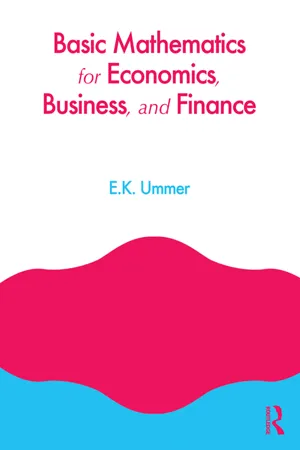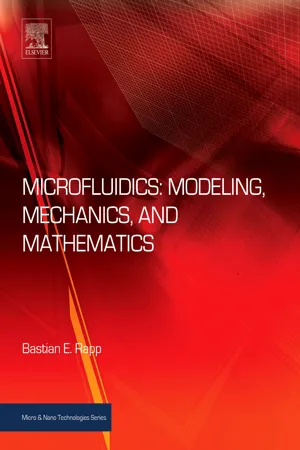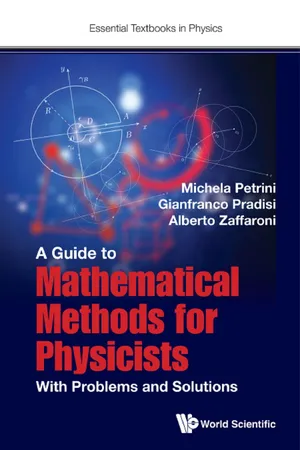Mathematics
Maclaurin Series
A Maclaurin series is a special case of a Taylor series, which is a representation of a function as an infinite sum of terms. The Maclaurin series is a Taylor series expansion of a function around zero, where the terms of the series are calculated using the function's derivatives evaluated at zero. It is named after Scottish mathematician Colin Maclaurin.
Written by Perlego with AI-assistance
Related key terms
Related key terms
1 of 4
Related key terms
1 of 3
3 Key excerpts on "Maclaurin Series"
- EK Ummer(Author)
- 2012(Publication Date)
- Routledge(Publisher)
nth-degree polynomial function is given asNotice that the only difference between Taylor series and Maclaurin Series (equations (3.6.7) and (3.6.2), respectively) is that if we use x0 = 0 in the former, we obtain the latter. Therefore, the Maclaurin Series is a special case of the Taylor series. What equation (3.6.7) says is that if we pick two numbers in the domain of the function (say, x = x1 = 10 and x0 = 5) and evaluate the RHS of equation (3.6.7), then the RHS will be equal to f (x = x1 = 10).3.6.4 Maclaurin and Taylor Series with RemaindersSo far, we have been concerned with the expansion of an nth-degree polynomial function into another nth-degree polynomial function. In fact, we can expand (around, say, x0 ) any function, say h(x), not necessarily a polynomial function, into a polynomial form. But, the condition for the expansion of an arbitrary function h(x) is that it must have finite, continuous derivatives up to the required degree at x0 .Taylor series with remainder is based on the Taylor theorem, which states that a function h(x) can be expanded around x0 aswhere the last term [hn +1 (x0 )/(n + 1)!].(x − x0 )n +1 = Rn is called the remainder or error of approximation. It can be shown that Rn → 0 as n → ∞. In this case, we will haveNotice that if we expand a polynomial function into another polynomial function of the same degree, then the term Rn will be equal to zero. If we expand h(x) around x = 0, then we havewhich is called the Maclaurin Series with remainder. Suppose we assume now that n = 0. In this case equation (3.6.8) will reduce to h(x) = [h(x0 )/0!] + [h′ (x0 )/1!].(x − x0 ) = h(x0 ) + h ′(x0 )(x − x0 ). This result is popularly called the mean-value theorem- Bastian E. Rapp(Author)
- 2016(Publication Date)
- Elsevier(Publisher)
Tab. 4.1 ) and can be conveniently evaluated using the zeta function.Fig. 4.1 The Riemann zeta function ζ (s).4.2 Taylor Series
4.2.1 Introduction
A Taylor 1 series or a Taylor series expansion is an approximation of an analytical function using an infinite sum of terms, i.e. , a polynomial. The idea that a function can be expressed as a sum of terms was suggested before, but Taylor was the first to introduce a general method for calculating these terms.Taylor series are very important tools in many areas of practical mathematics. In many applications, it is impossible to find a closed analytical expression of a function. In such scenarios, it may sometimes be significantly easier to approximate the function by a given number of terms, i.e. , a polynomial. Obviously, if we are talking about an infinite sum, there would be an infinite number of terms in this polynomial one needs to take into account. However, in many scenarios, it is acceptable to consider only a finite number of terms and thus approximate the function taking into account that the result may be incorrect to a small degree. Obviously, the higher the number of terms considered, the smaller the error.A Taylor series is, so to speak, the link between analytical and numerical calculus. Whenever numerical approximations of problems such as solutions to PDEs are to be found, we very often have no other choice but to default to numerical approximations of the solution because finding the exact analytical solution is not possible.A number of prerequisites must be fulfilled in order to be able to work with a Taylor series. As this book does not intend to give a fully accounted introduction to Taylor series, we will restrict ourselves to a few easy-to-understand requirements. First of all, a Taylor series is always constructed at a given point of the function. We usually say that the Taylor series is “created around” or “expanded around” a given value a . If we move away from the point a , the Taylor series will give a less ideal approximation of the function. Therefore, in order to construct a function in a given domain, we may need to create many series at different points a 1 , a 2 , a 3 , and so on in order to obtain a good approximation. As we will see, the Taylor series expansion uses the derivatives of the function. Obviously one could argue, if we do not know the function, chances are we do not know anything about the derivatives. This is often not true. Many problems in practical physics and mathematics are described by (partial) differential equations. In these cases, we may know nothing of a function itself, i.e.- eBook - ePub
A Guide to Mathematical Methods for Physicists
With Problems and Solutions
- Michela Petrini, Gianfranco Pradisi, Alberto Zaffaroni(Authors)
- 2017(Publication Date)
- WSPC (EUROPE)(Publisher)
In this chapter, we will see how to extend to complex functions the notion of series expansion. A holomorphic function can always be expressed as a Taylor series around any point of its domain of holomorphicity. Another novelty of complex analysis is that holomorphic functions admit a series expansion also around isolated singularities. This series expansion is known as the Laurent series.3.1.Power Series
Let us first recall the notion of series of functions. Given a sequence {fk }, k ∈ N , of functions fk : C → C , we call series the infinite sumThe series (3.1) is said to be convergent if the sequence of partial sumsconverges. The limit of the sequence of partial sums, limn→∞ Sn (z) = S(z), is called sum of the series. We refer to Appendix A.2 for a brief summary of series of functions and their convergence properties.In this section, we are interested in a particular class of series of functions, the power series. These are defined aswhere the coefficients an are complex numbers and z0 is a point of the complex plane, called the centre of the series. Power series have very nice properties that we first illustrate with an example.Example 3.1. Consider the geometric seriesThe nth partial sum is given bywhere we used the factorisation properties of polynomials on C . From the expression above one clearly sees that the limit of the sequence {Sn } for n → ∞ depends on the value of the variable z. For |z| < 1, we haveand the series converges to S(z) = 1/(1 − z). On the contrary, for |z| > 1, limn→∞ Sn (z) = ∞ and the series diverges. To study the behaviour for |z| = 1, we can set z = eiθ directly in (3.4). For any fixed value of θ this is a numerical series an that does not converge, since it does not satisfy the necessary condition limn→∞ an = 0. In summary, we showed that the geometric series converges point-wise for |z| < 1 and diverges for |z| ≥ 1. We also want to see whether there is a region of the complex plane where the series also converges uniformly. A series converges uniformly on a region K
Index pages curate the most relevant extracts from our library of academic textbooks. They’ve been created using an in-house natural language model (NLM), each adding context and meaning to key research topics.
Explore more topic indexes
Explore more topic indexes
1 of 6
Explore more topic indexes
1 of 4


